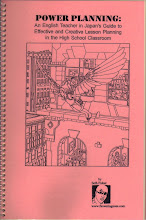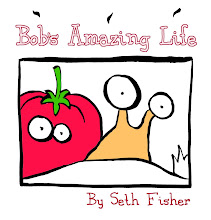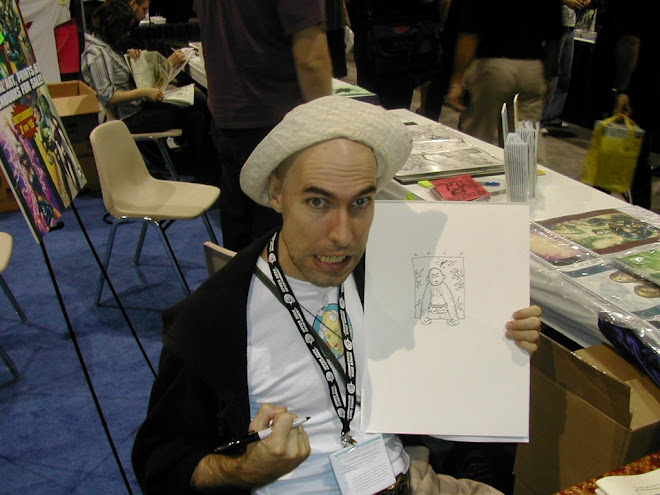 Judith Johnson continues:
Judith Johnson continues:"Next we look at the picture plane, the imaginary or real line that surrounds the illustration. Is it full (lots of things are close together in the drawing)? Or sparse (few things, far apart in the drawing)? Is the picture within the plane or does it break out of it (are there parts of objects which extend beyond the picture plane)? What is the shape of thepicture plane (is it rectangular, square, round, oval, or shaped by the objects within it)?"
In this page at least, the picture is pretty full of Things. One of the qualities that Seth's work is known for is the abundance of detail, and this page is no exception. The surface is densely covered with lines. Seth's lines are never just texture or shading, however: it's full of information. But he used small details to show depth and--as in the Big in Japan cover that I posted last--to make a group of things or beings function pictorially as a single unit. The hordes that are attacking our protagonists are separate, but seen as one single large threat. Our friends are each drawn separately, each in his/her own space. They are individuals; the creatures in the attacking army are not.
But Seth was not afraid of open space in his drawings. The area above Hal and his friends is blank except for the words. Dense detail requires some open space so the viewer's eyes can rest a little bit.
"What is the quality of the lines in the illustration? Are they thick, thin, horizontal, vertical, diagonal, straight or curvilinear? A thick vertical line might represent strength (think of a tall oak tree). A thin, curvilinear line might appear feminine and lyrical (think of a flower stem, bending in the wind). A diagonal line might appear visually startling (think of lightning). Does the artist use implied line? Implied line happens when a line begins in one object, such as an arm pointing, and continues in another object such as the crest of a hill. Our eyes do not see two different lines, but one continuous line is “implied.” Implied lines can also be seen in the combined edges of things, especially when the artist ends linear items such as hair or tree limbs in one continuous curved line."
This picture has, not so much implied line, as it has implied continuity of movement.
In comic book work the artist has several pictures on one page to work with, and so he has more opportunity than single-image artists to make the images work or play together. Seth loved visual puns (and verbal ones too). In the bottom two frames on this page, the advancing army begins to press against Hal on the left, and then on the right it seems as though the same group from the left is just leaning so hard on him that he can't remain upright. The shield that he holds in the left frame acts like open space which makes the movement in the two frames go from upper left to lower right, pressing Hal and his friends into the bottom of the page. The hordes are not so much threatening as they are carelessly trampling everything in their path.





1 comment:
It's my page! :)
I think you're right, Vicki: the whole general flow is from the top left to the bottom right - a pressing down (which is exactly what is required from an action point of view).
On another topic, I love the idea that the 'monster' - representing the unconscious - is a many-tentackled, unstoppable thing, like a hydra (you cut off one limb...). This really is my favourite book of Seth's, for many reasons.
Post a Comment